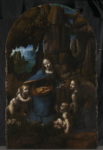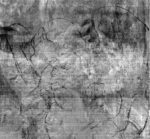 Researchers at London’s National Gallery have identified original drawings by Leonardo da Vinci under The Virgin of the Rocks. An earlier examination of the work in 2004/5 had found changes to the Virgin’s pose. Vague indicators of other figures in the composition were thought to be line changes between the original pose and the final one. A new analysis using the latest imaging technology revealed there were two compositions under the painting. In the initial design, the angel and Christ child were markedly different than they turned out to be in the end.
Researchers at London’s National Gallery have identified original drawings by Leonardo da Vinci under The Virgin of the Rocks. An earlier examination of the work in 2004/5 had found changes to the Virgin’s pose. Vague indicators of other figures in the composition were thought to be line changes between the original pose and the final one. A new analysis using the latest imaging technology revealed there were two compositions under the painting. In the initial design, the angel and Christ child were markedly different than they turned out to be in the end.
In the abandoned composition both figures are positioned higher up, while the angel, facing out, is looking down on the Infant Christ with what appears to be a much tighter embrace. These new images were found because the drawings were made in a material that contained some zinc, so it could be seen in the macro x-ray fluorescence (MA-XRF) maps showing where this chemical element was present, and also through new infrared and hyperspectral imaging.
Why Leonardo abandoned this first composition still remains a mystery. The new research has shown how the second underdrawing, while aligning much more closely to the finished version, nonetheless displays his characteristic elaborations and adjustments from drawing to painting. For instance, the angle of the Infant Christ’s head was changed so that he was seen in profile, while some parts of the angel’s curly hair have been removed. Handprints resulting from patting down the priming on the panel to create an even layer of more or less uniform thickness can also be seen, probably the work of an assistant – but perhaps even by Leonardo himself.
 It’s a particularly intriguing find given the complicated history behind the composition of the piece. Commissioned in 1483 by the Confraternity of the Immaculate Conception for their chapel abutting the Church of San Francesco Grande in Milan, the painting as originally envisaged by the confraternity was a traditional Renaissance view of the Immaculate Conception — Mary, angels, an architectural setting — but Leonardo instead went his own way, creating a rocky, humid, cave-like setting and depicting the Virgin, the Christ Child and John the Baptist. This was his first commission in Milan; you’d think he might try to please his clients instead of blowing them off in favor of his own vision. The result caused some consternation among the confraternity and when Leonardo did not get paid the full amount, he sold the painting to a private buyer. That first version of the Virgin on the Rocks is now at the Louvre.
It’s a particularly intriguing find given the complicated history behind the composition of the piece. Commissioned in 1483 by the Confraternity of the Immaculate Conception for their chapel abutting the Church of San Francesco Grande in Milan, the painting as originally envisaged by the confraternity was a traditional Renaissance view of the Immaculate Conception — Mary, angels, an architectural setting — but Leonardo instead went his own way, creating a rocky, humid, cave-like setting and depicting the Virgin, the Christ Child and John the Baptist. This was his first commission in Milan; you’d think he might try to please his clients instead of blowing them off in favor of his own vision. The result caused some consternation among the confraternity and when Leonardo did not get paid the full amount, he sold the painting to a private buyer. That first version of the Virgin on the Rocks is now at the Louvre.
 Ten years later, Leonardo began working on a second version, likely because the confraternity paid its balance. It was the exact same dimension (the arch-shaped frame was already made, after all) and the same subject, but with notable differences in composition and palette. The newly-discovered underdrawings are certainly in his hand, which is not the case for the application of the paint itself, so they uniquely show the false starts and evolution of Leonardo’s vision for the work.
Ten years later, Leonardo began working on a second version, likely because the confraternity paid its balance. It was the exact same dimension (the arch-shaped frame was already made, after all) and the same subject, but with notable differences in composition and palette. The newly-discovered underdrawings are certainly in his hand, which is not the case for the application of the paint itself, so they uniquely show the false starts and evolution of Leonardo’s vision for the work.
 Starting November 9, 2019, the National Gallery will host a new exhibition centered around The Virgin of the Rocks. Leonardo: Experience a Masterpiece takes an innovative approach to give visitors an immersive experience into the context of the painting and of its creator.
Starting November 9, 2019, the National Gallery will host a new exhibition centered around The Virgin of the Rocks. Leonardo: Experience a Masterpiece takes an innovative approach to give visitors an immersive experience into the context of the painting and of its creator.
A wide range of multi-sensory experiences will be presented across four separate rooms. Visitors will be able to step inside a similar chapel setting and see what art historical research suggests the painting’s setting may have looked like. They will be able to explore Leonardo’s own research, which informed the specific compositions in the painting. In addition they will see how Leonardo used his scientific studies to create strong effects of light and shadow in his painting. The modern process of discovery in a conservation studio, where the mysteries and secrets of a painting are uncovered, will also be brought to life with visitors being able to engage in detail with the latest findings underneath ‘The Virgin of the Rocks’.